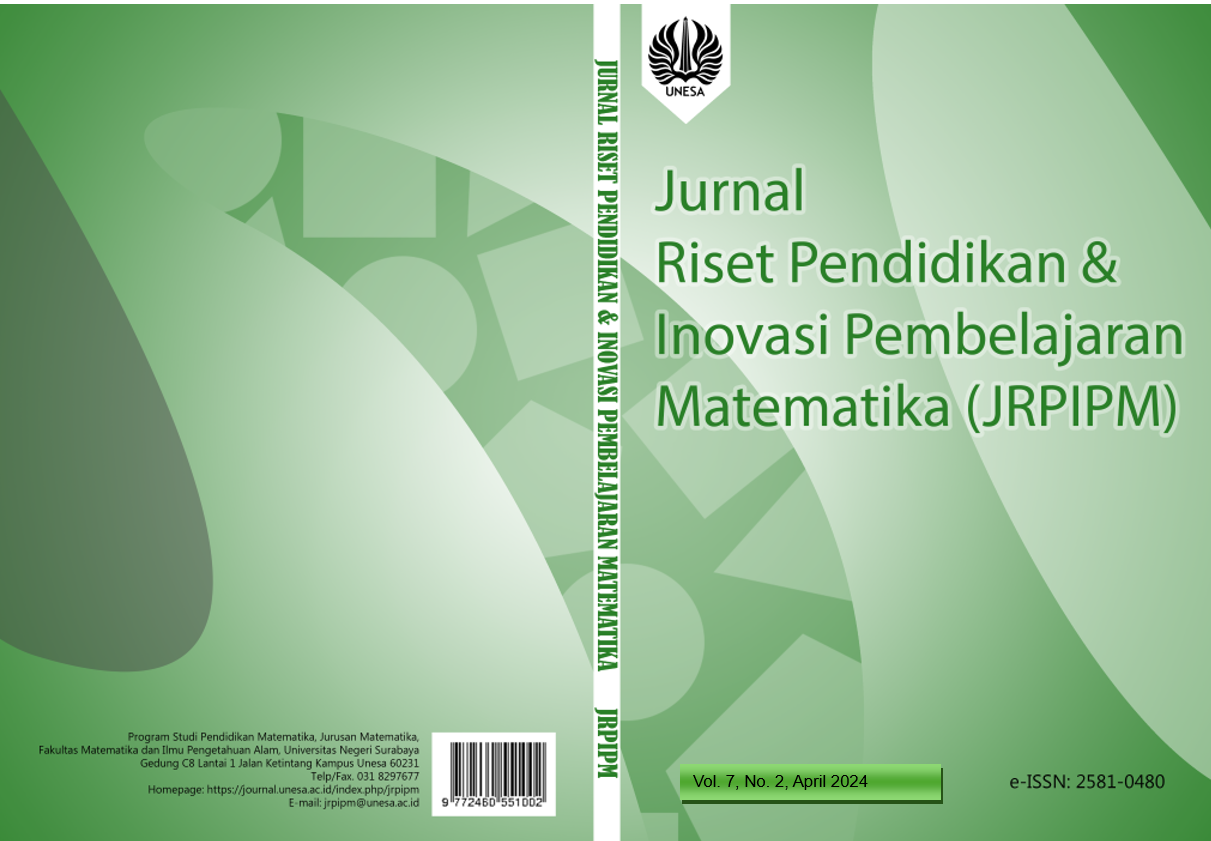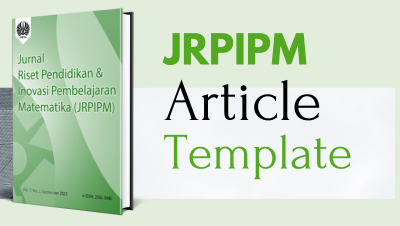Development of Teaching Materials Based on Pjbl-Abmh (Preserved Bioplastic Materials Set) To Improve Students' Creative Thinking Skills
DOI:
https://doi.org/10.26740/jrpipm.v7n2.p117-139Keywords:
Sets, Creative Thinking Skills, PJBL-ABMH based Learning ToolsAbstract
This research describes the process and results of developing PJBL-ABMH-based learning tools to improve students' creative thinking abilities on set material. This research uses the Plomp development model to develop learning tools through teaching modules and project worksheets, setting material with the PJBL-ABMH project learning design. The trial was conducted on 6 grade 7 students at a junior high school in Surabaya, East Java. Data collection and analysis techniques are carried out using validation sheets to determine the validity of the learning tools tested on the validator. Pre-test and posttest sheets measure effectiveness regarding students' creative thinking abilities on set material. Apart from that, student response sheets are also used to determine the practicality of the learning tools that have been developed. Data analysis was carried out using the constant comparative method technique. The results of the data analysis showed that the learning tools obtained a validity criterion of 75.5%, and each was classified as valid. The n-gain was obtained at 0.736 for the effectiveness criteria, and each obtained high effectiveness criteria. The learning tools were efficient to implement, with an average student response of 90% for the project learning design. Thus, PJBL-ABMH-based learning tools are declared valid, effective, and practical.
References
Adinugraha, F. (2018). Model Pembelajaran Berbasis Proyek pada Mata Kuliah Media Pembelajaran. Jurnal SAP (Susunan Artikel Pendidikan), 3(1), 1-9. http://dx.doi.org/10.30998/sap.v3i1.2728
Ahmad, S. (2020). Penyusunan Skala Psikologi. Jakarta: Kencana
Akker, V. J., Bannan, B., Kelly, A. E., Nieveen, N., & Plomp, T. (2013). Educational Design Research. Part (A): An Introduction. Enschede: Enschede, the Netherlands: Netherlands: Institute for Curriculum Development (SLO).
Beneroso, D., & Robinson, J. (2022). Online project-based learning in engineering design: Supporting the acquisition of design skills. Education for Chemical Engineers, 38, 38-47. https://doi.org/10.1016/j.ece.2021.09.002
Bhardwaj, P. (2019). Types of sampling in research. Journal of Primary Care Specialties, 5(3), 157-163.
Corebima, A. D., Susilo, H., & Zubaidah, S. (2017). Creative Thinking of Low Academic Student Undergoing Search Solve Create and Share Learning Integrated with Metacognitive Strategy. International Journal of Instruction, 10(2), 245-262. http://www.eiji.net/dosyalar/iji_2017_2_16.pdf
Florida, R., Mellander, C., & King, K. (2015). The global creativity index 2015. Martin Prosperity Institute.
Handayani, S.A., Rahayu, Y.S., & Rudiana, A. (2020). Improving Student Creative Thingking Skills through Google Classroom Assisted GO-KAR Model During the Covid-19 Pandemi. International Journal of Engineering Research and Technology. 13(12), 4616-4621. https://pesquisa.bvsalud.org/global-literature-on-novel-coronavirus-2019-ncov/resource/pt/covidwho-1037807
Handayani, T. L., Retnoningsih, A., & Herlina, L. (2013). Efektivitas Group Investigation Ditunjang Penugasan Awetan Bioplastik Terhadap Hasil Belajar dan Minat Wirausaha. Journal of Biology Education, 2(1), 73-81. https://doi.org/10.15294/jbe.v2i1.2617
Hardianto, H., & Baharuddin, M. R. (2019). Efektifitas Penerapan Model Pembelajaran Paikem Gembrot terhadap Peningkatan Hasil Belajar Mahasiswa pada Mata Kuliah Pembelajaran Matematika Sekolah Dasar. Cokroaminoto Journal of Primary Education, 2(1), 27-33. https://doi.org/10.30605/cjpe.212019.105
Hidayah, E. N., Farihah, U., & Nasution, N. E. A. (2022). The Effect of STEM integrated with Project Based Learning (PJBL) Model of Respiratory System Material to Students Activities and Learning Outcomes. Proceeding Cgant Unej.
Israri, F. N., Isnawati, I., & Ambarwati, R. (2017). Kelayakan Media dan LKS Awetan Bioplastik Arthropoda Untuk Meningkatkan Minat Wirausaha Siswa. Berkala Ilmiah Pendidikan Biologi (BioEdu), 6(3), 374-381.
Jawad, L. F., Majeed, B. H., & Alrikabi, H. T. S. (2021). The Impact of Teaching by Using STEM Approach in The Development of Creative Thinking and Mathematical Achievement Among the Students of The Fourth Scientific Class. International Journal of Interactive Mobile Technologies. 15(13), 172-188. https://doi.org/10.3991/ijim.v15i13.24185
Kemendikbud. (2017). Panduan Implementasi Kecakapan Abad 21 Kurikulum 2013 di Sekolah Menengah Atas. Jakarta: Kementerian Pendidikan dan Kebudayaan Indonesia
Khamhaengpol, A., Sriprom, M., & Chuamchaitrakool, P. (2021). Development of STEAM Activity on Nanotechnology to Determine Basic Science Process Skills and Engineering Design Process for High School Students. Thinking Skills and Creativity, 39, 100796. https://doi.org/10.1016/j.tsc.2021.100796
Kristiani, N., Hasanah, U., Hunaenah, N., Moroki, E. S. G., Kadariyah, N., & Ibayati, Y. (2018). Modul pelatihan kurikulum 2013 bagi kepala sekolah tahun 2018: Manajemen Implementasi Kurikulum 2013 Jenjang SMA.
Le, L. T. B., Tran, T. T., & Tran, N. H. (2021). Challenges to STEM education in Vietnamese high school contexts. Heliyon, 7(12), e08649. https://doi.org/10.1016/j.heliyon.2021.e08649
Lubis, Fitri A. (2018). Upaya Meningkatkan Kreativitas Siswa Melalui Model Project Based Learning. PeTeKa (Jurnal Penelitian Tindakan Kelas dan Pengembangan Pembelajaran), 1(3), 192-201
Mardapi, D. (2012). Pengukuran Penilaian & Evaluasi Pendidikan. Yogyakarta: Nuha Medika.
Mubarokah, N. L., & Wahyudi. (2019). Peningkatan Berpikir Kreatif Pembelajaran Tematik Melalui Penerapan Model Pembelajaran PjBL Siswa SD. Jurnal Pendidikan Surya Edukasi (JPSE). 5(1), 49-57
Munandar, U. (2012). Pengembangan Kreativitas Anak Berbakat. Rineka Cipta
Natsir, N., Tandiayuk, M. B., & Karniman, T. S. (2016). Profil kesalahan konseptual dan prosedural siswa dalam menyelesaikan soal cerita himpunan di Kelas VII SMPN 1 Siniu. Jurnal Elektronik Pendidikan Matematika Tadulako, 3(4).
Noether, G. E. (1992). Introduction to Wilcoxon (1945) Individual Comparisons by Ranking Methods, Kotz, S., Johnson, N.L. (eds) Breakthroughs in Statistics, Springer Series in Statistics, Springer, New York, NY, https://doi.org/10.1007/978-1-4612-4380-9_15
Plomp, T., & Nieveen, N. (2013). Educational Design Research. Enchede: Netherlands Institute for curriculum development.
Prihartiwi, N., Hidayat, D., & Kohar, A. W. (2020). Analisis kemampuan berpikir kritis mahasiswa dalam membuat prediksi berdasarkan grafik. GAUSS: Jurnal Pendidikan Matematika, 3(2), 43-54.
Risnanosanti, R., Syofiana, M., & Hasdelyati, H. (2020). Kemampuan Berpikir Kreatif Matematis Siswa dan Model Pembelajaran Problem Solving Berbasis Lesson Study. INDIKTIKA (Jurnal Inovasi Pendidikan Matematika), 2(2), 168-178. http://dx.doi.org/10.31851/indiktika.v2i2.4137
Riyadi, M., & Rahayu, Y. (2017, October). Strengthening the 21st century skills of elementary school students through the implementation of project based learning. In Social Sciences, Humanities and Economics Conference (SoSHEC 2017) (pp. 253-255). Atlantis Press.
Rohana, R.S & Wahyudin, D. (2017). Project Based Learning Untuk Meningkatkan Berpikir Kreatif siswa SD Pada Materi Makanan Dan Kesehatan. Jurnal Penelitian Pendidikan, 16(3), 235-243
Sagala, Y. D. A., & Simanjuntak, M. P. (2019). Implementation of project-based learning (PjBL) in collaboration skills and communication skills of students.
Setiyowati, Y., & Shodikin, A. (2022). Analysis of Student's Critical Thinking Ability in Solving HOTS (Higher-Order Thinking Skills) Problems With Creative Problem-Solving Model. Inspiramatika, 8(1), 13-20. https://doi.org/10.52166/inspiramatika.v8i1.2793
Sirajudin, N., Suratno, J., & Pamuti. (2021). Developing creativity through STEM education. Journal of Physics: Conference Series. https://doi.org/10.1088/1742-6596/1806/1/012211
Sumarno, W. K., Riyantoko, K., Shodikin, A. (2024). Effectiveness of Bilingual Project-Based Materials to Facilitate Literacy and Numeracy Teaching. Effectiveness of Bilingual Project-Based Materials to Facilitate Literacy and Numeracy Teaching. TEM Journal 13(1), 68-76.
Tri, M., & Novisita, R. (2018). Analisis Kemampuan Berpikir Kreatif Siswa SMP dalam Memecahkan Masalah Matematika Pada Materi Pola Barisan Bilangan. Jurnal Pendidikan Berkarakter. 1(1). 34-41
Tsupros, N., Kohler, R., & Hallinen, J. (2009). STEM education: A project to identify the missing components. Intermediate Unit 1: Center for STEM Education and Leonard Gelfand Center for Service Learning and Outreach.
Waluya, S. B., & Asikin, M. (2020). The Important of Creative Thinking Ability in Elementary School Students for 4.0 Era. International Journal on Educational, Management and Innovation, 1(1), 91. http://journal2.uad.ac.id/index.php/ijemi
Yulianti, D., Wijayanto., Rusilowati, A., & Nugroho, S. E. (2020). Student worksheets based on Science, Technology, Engineering and Mathematics (STEM) to facilitate the development of critical and creative thinking skills. Journal of Physics: Conference Series. https://doi.org/10.1088/1742-6596/1567/2/022068
Zahroh, F. (2020). Pengaruh Model Pembelajaran Project Based Learning Terhadap Kemampuan Berpikir Kritis Siswa Pada Materi Elektrokimia. Phenomenon: Jurnal Pendidikan MIPA, 10(2), 191-203. https://doi.org/10.21580/phen.202 0.10.2.4283
Zulaikha, N. F., Maharani, H. R., & Basir, M. A. (2020). Analisis tingkat kemampuan berpikir kreatif materi trigonometri. Buana Matematika: Jurnal Ilmiah Matematika Dan Pendidikan Matematika, 10(2), 157-174. https://doi.org/10.36456/buanamatematika.v10i2.2717
Downloads
Published
How to Cite
Issue
Section
 Abstract views: 212
,
Abstract views: 212
, PDF Downloads: 285
PDF Downloads: 285







